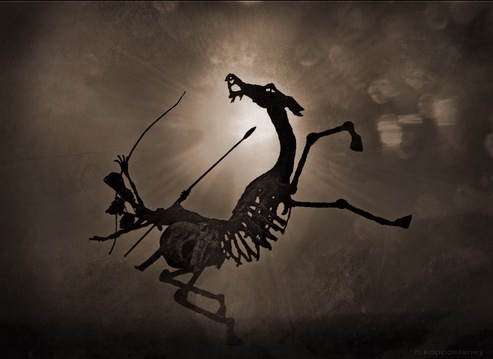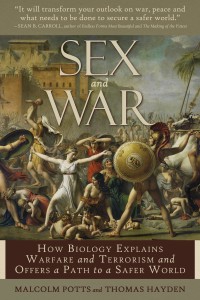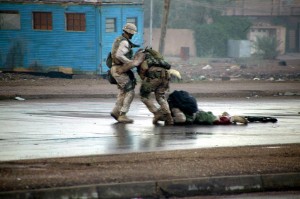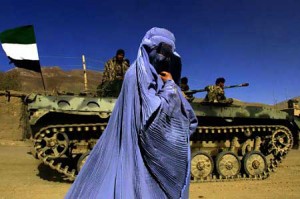 In 2008, I published a book about the evolutionary origins and cultural development of warfare throughout human history. John Horgan, about as distinguished a science writer as one is likely to find, graciously invited me to share my thoughts on war’s deep past and possible futures on a web video show he hosted. It was an extremely pleasant experience, but that, apparently, was just because John is polite. It turns out he disagrees with me utterly about a key conclusion of Sex and War, namely that … oh, but why give it away? We decded to continue the conversation here at LWON, and to help keep the discussion of war from coming to virtual blows, we asked the very peaceable Ann Finkbeiner to referee. A very lightly edited version of the resulting virtual chat unspools below:
In 2008, I published a book about the evolutionary origins and cultural development of warfare throughout human history. John Horgan, about as distinguished a science writer as one is likely to find, graciously invited me to share my thoughts on war’s deep past and possible futures on a web video show he hosted. It was an extremely pleasant experience, but that, apparently, was just because John is polite. It turns out he disagrees with me utterly about a key conclusion of Sex and War, namely that … oh, but why give it away? We decded to continue the conversation here at LWON, and to help keep the discussion of war from coming to virtual blows, we asked the very peaceable Ann Finkbeiner to referee. A very lightly edited version of the resulting virtual chat unspools below:

Ann: I understand both of you have written authoritative and charming books on war — John’s, just out, is called The End of War; and Tom’s is Sex and War — and that you’ve discussed these matters before. I also understand you disagree about war. How could you not agree? I mean, war is just nasty stuff and we shouldn’t do it, right?
Tom: Ann, you’re poking the hornet’s nest right off the bat! I don’t think John and I disagree about war, but rather about peace. Don’t get me wrong: we both prefer the latter to the former, by a wide margin. And there are many things we do agree on, I think, such as the substantial observed decrease in the frequency and lethality of war over the past several centuries, and the idea that culture is an important part of the balance between war and peace. But I think we do have a difference of opinion about the attainability of peace (John) versus the inevitability of war (me). I think this makes John a better person than me, and certainly a more optimistic one. And I really, really hope he’s right. In my mind it comes down to an argument about human nature, and whether the impulses and behaviors of war are inborn or acquired. Or at least, that’s my take. John, what’s yours?
 John: Trying to disarm me with your kind words, eh Tom? In the spirit of peace, I think we agree on some very important issues, namely that war is a problem that can be analyzed and possibly even solved with the help of science, that sexuality and gender are extremely important factors, and that both nature and nurture contribute to war’s persistence. Our biggest disagreement consists of the degree to which war is ancient and innate. Correct me if I’m wrong, but you and your co-author Malcolm Potts seem to subscribe to the notion that war — lethal group (as opposed to individual) violence — dates back millions of years to our common ancestor with chimpanzees. I believe that this theory is wrong, and I devote much of my book to showing why. Should we focus on this issue for starters?
John: Trying to disarm me with your kind words, eh Tom? In the spirit of peace, I think we agree on some very important issues, namely that war is a problem that can be analyzed and possibly even solved with the help of science, that sexuality and gender are extremely important factors, and that both nature and nurture contribute to war’s persistence. Our biggest disagreement consists of the degree to which war is ancient and innate. Correct me if I’m wrong, but you and your co-author Malcolm Potts seem to subscribe to the notion that war — lethal group (as opposed to individual) violence — dates back millions of years to our common ancestor with chimpanzees. I believe that this theory is wrong, and I devote much of my book to showing why. Should we focus on this issue for starters?
Ann: And can we focus on theories that have some evidence? I love theories with evidence. So the argument between Tom and John, about whether war is inborn or acquired, can be settled by looking at our ancestors; and if they warred, then war is inborn; and if they don’t, it’s acquired? Surely we have evidence that chimpanzees fight, right? Is fighting different from war? Is that what John meant when he said “group (as opposed to individual) violence?” So then, a group of chimps gets together and fights somebody else and that’s war? And remind me to ask you about an assumption you’re both making, that sex and gender are related to war.
Tom: Okay, let’s get to the sex and gender next, and tackle the innateness of warring behaviors first. John is right — Malcolm and I do propose that war is an innate human behavior, and that it goes back through history and prehistory, to an origin in a common ancestor we share with chimpanzees. We define war, by the way, as a group behavior in which individuals band together into cohesive units and set out intentionally to attack and kill neighboring members of their own species. The salient points are that it is a group behavior, it is an intentional behavior, and it is intentionally lethal — lots of creatures are violent, but the intentional slaughter of one’s own species is terrifically rare in nature — and that it is almost always a male behavior, not a female one.
And you guessed it Ann — chimpanzees, our closet genetic relatives, are one of the few species other than humans who do it. (Consistent with an evolutionary basis for warfare, but not proof by itself: bonobos, the so-called pygmy chimps, appear to be much less violent than chimpanzees, at least under current conditions; and the other species that conduct wars include ants and wolves … the conclusion must be that war has evolved more than once.)
Anyway, why do we say it’s ancestral? Because a) only a few species anywhere have warring behavior, and we and our closest genetic relatives both do it; b) there is evidence of war from every time period and every known culture in human history and c) I’m Catholic, and can’t get notions of original sin out of my mind. War is our species’ evolutionary original sin. Okay, joking a little on that last one. If pushed, I would substitute that c) there is robust theoretical logic supporting the evolutionary advantage of warfare to young human and chimp males, given the male-dominated social structure of both chimp and early human societies.
That’s our theory, or the first half of it anyway, and a bit of the evidence. But I’m kind of giddily eager to hear my many years’ labor torn to shreds. Let ‘er rip, John!

John: Tom, thanks for a good summary of what I call the deep-roots thesis. Here is some counter-evidence. First, lethal raiding by one chimpanzee troop against another is “rare,” as even Richard Wrangham, a major proponent of the deep-roots theory, has acknowledged. Researchers would have to watch a typical troop for 7 years before seeing a single lethal attack. Jane Goodall observed chimps for 15 years before the first incident, and she suspected the violence stemmed from chimps’ competition for food that she was supplying. Other scholars blame human encroachment on chimps’ habitat for inter-group violence. Some chimp communities — and bonobos in general — have never been observed engaging in deadly attacks. But much more importantly, there is no evidence of hominid or human group violence (as opposed to isolated acts of violence) dating back millions or even tens of thousands of years. The oldest evidence of deadly group violence by humans — a mass grave in the Nile Valley — is about 13,000 years old, and even that is an outlier. The vast bulk of evidence dates from 10,000 years ago or less, leading scholars such as Sarah Blaffer Hrdy, Doug Fry, Jonathan Haas and Erik Trinhaus to conclude that war is a relatively recent cultural phenomenon, associated often — but not always! — with agriculture and permanent settlements. (Hunter-gatherers are not all pacifists, as some scholars have claimed.) In response to my argument, some skeptics say, Well, we don’t have good evidence of any human behaviors more than 10,000 years ago. Actually, we have evidence of many complex cultural behaviors — tool-making, hunting, cooking, art, music, religion — emerging far back in the Paleolithic era, but not war. The evidence is clear: war is a recent cultural phenomenon that culture can help us transcend.
Ann: Ok, as long as we’re clear about what’s theory and what’s evidence, and I think we have been. So Tom says our ancestors and chimps do go to war and John says yes, but rarely. And Tom says every human culture over time goes to war and John says, well, only in the last 10,000 years. And then they both make flying leaps and cite the “robust theoretical logic” for evolutionary advantage (Tom) and “recent cultural phenomena that [therefore] culture can help us transcend” (John) and whoosh, I just don’t know what to believe. However, I can live without knowing what to believe. What I really want to know is, what does sex and gender have to do with war? And should I even try to stipulate that we continue to focus on theories with evidence?
Tom: Okay, okay, gender. In a sec — but the key thing about chimps going to war is that they do at all, not that they do with one frequency or another. And as John himself points out, hunter-gatherers are not pacifists — in fact, all the extant groups studied show much higher rates of adult death via warfare than any settled societies, our own included. And that’s another analogue for our prehistoric behavior as a whole species. Plus, I think John glosses over the reality that the historical and archaeological records are very, very sketchy pre-10,000 years ago. And that kind of makes it easy to see what one wants in the ancient record. Me, I see a mass grave at 13,000 years ago as evidence that war was what was what then, and for a long time before. But I can also concede that that’s not so different from John seeing a bone flute and some ochre scratchings in a cave in South Africa and deducing the presence of a paleolithic chamber orchestra 100,000 years ago. (Huh, that was an uncharacteristically sharp dig, especially since I buy the patchy art, music, religion etc evidence too.) The why of that is really important: Just like chimps, humans don’t fight wars all the time; just like chimps, we do lots of other stuff, too; and just like chimps, our physical, social and cultural environment has a really significant impact on how likely we are to fight wars.
 Now, about that gender thing. That’s where the robust evolutionary logic comes in, too. Here’s the observation: throughout history, across cultures and in chimpanzees, too, the great majority of warring is done by males, and young males at that. Women can and do fight bravely, but outside of extreme circumstances they don’t typically band together for spontaneous, unprovoked slaughter of neighboring groups of people, as men most certainly do. (It’s obvious that I mean, men sometimes do, right? I’ve never done it myself, for example.) Why? Well, testosterone. But more helpfully, because of how early human societies were almost certainly structured. Like extant chimpanzee and hunter-gatherer societies, our forebears probably lived in smallish, male-dominated clans or family groups, in which male descendants stayed within the group rather than roaming and joining or establishing others. Because of tight hierarchies, dominant males were the only ones with the opportunity to reproduce. To do so, a young male had either to fight his way up the chain of command, sneak about for secret assignations with female members of his own band or others, or, take the risk of fighting males of another band for access to that band’s females. (Genetic studies in chimps show this is so; historical evidence from Ghenghis Khan to the Inca do too.) That big risk would be substantially decreased by banding together with other males from your own group, and reduced again by raiding attacks, in which your band attacks and kills individuals of another group, sequentially taking them out over time. That’s how chimpanzees fight, that’s how hunter-gatherers fight, and that’s how most bands of blood-relative warriors have fought over time. Voila — you have a strong positive feedback system that encourages the traits that make successful young male warriors — external aggression, internal cohesion, and the remarkable ability of a social animal to dehumanize its rivals. (Without that last, war as we know it simply wouldn’t be possible.) And those traits are all much stronger, typically, in young males than in older males or females.
Now, about that gender thing. That’s where the robust evolutionary logic comes in, too. Here’s the observation: throughout history, across cultures and in chimpanzees, too, the great majority of warring is done by males, and young males at that. Women can and do fight bravely, but outside of extreme circumstances they don’t typically band together for spontaneous, unprovoked slaughter of neighboring groups of people, as men most certainly do. (It’s obvious that I mean, men sometimes do, right? I’ve never done it myself, for example.) Why? Well, testosterone. But more helpfully, because of how early human societies were almost certainly structured. Like extant chimpanzee and hunter-gatherer societies, our forebears probably lived in smallish, male-dominated clans or family groups, in which male descendants stayed within the group rather than roaming and joining or establishing others. Because of tight hierarchies, dominant males were the only ones with the opportunity to reproduce. To do so, a young male had either to fight his way up the chain of command, sneak about for secret assignations with female members of his own band or others, or, take the risk of fighting males of another band for access to that band’s females. (Genetic studies in chimps show this is so; historical evidence from Ghenghis Khan to the Inca do too.) That big risk would be substantially decreased by banding together with other males from your own group, and reduced again by raiding attacks, in which your band attacks and kills individuals of another group, sequentially taking them out over time. That’s how chimpanzees fight, that’s how hunter-gatherers fight, and that’s how most bands of blood-relative warriors have fought over time. Voila — you have a strong positive feedback system that encourages the traits that make successful young male warriors — external aggression, internal cohesion, and the remarkable ability of a social animal to dehumanize its rivals. (Without that last, war as we know it simply wouldn’t be possible.) And those traits are all much stronger, typically, in young males than in older males or females.
(I know, I know–what about Margaret Thatcher. I haven’t seen “The Iron Lady” yet, but if memory serves, Iron Maggie didn’t spontaneously join up with a tight-knit band of others and head out to combat “the other.” Rather, she manipulated the young male tendency to do so, in service of her larger political goals.)
John: Tom, I like the analogy of Paleolithic bone flutes being equated with orchestral music! Shoulda thought of that myself. But briefly: modern hunter-gatherers such as the !Kung and Hadza are largely nonviolent, and archaeological digs show that many early societies — including hunter-gatherers in the American southwest and horticulturalists in Abu Hureya, near the Euphrates — endured for centuries and even millennia while leaving no signs of warfare. No skeletons with hack marks, fortifications, weapons and shields obviously designed for war (as opposed to hunting). I harp on this point because the deep-roots theory of war leads many modern pundits — and leaders such as Barack Obama — toward a view of war as a permanent part of the human condition, or at the very least as a behavior that will be extremely difficult to eradicate. We shouldn’t be able to resort to spurious science to justify such fatalism. (For more on this debate, see my book or this column I wrote for Scientific American.)
 Now, as for the gender factor: I think that Tom and Potts do a brilliant job revealing the connection of gender/sex to war, as does Joshua Goldstein in War and Gender. But Goldstein shows how war shapes gender roles at least as much as vice versa; Sarah Blaffer Hrdy makes this same point in Mothers and Others. The emergence of war among early societies, simple and complex, gave rise to warrior cultures, which equated manliness with ferocity, courage and martial skill. The fact that extremely warlike cultures — notably Imperial Japan and Nazi Germany — can become pacifistic virtually overnight shows the degree to which culture, more than innate impulses, drives militarism. Most men are NOT natural warriors; they become warriors because they are sheep, who adopt their culture’s values, rather than wolves.
Now, as for the gender factor: I think that Tom and Potts do a brilliant job revealing the connection of gender/sex to war, as does Joshua Goldstein in War and Gender. But Goldstein shows how war shapes gender roles at least as much as vice versa; Sarah Blaffer Hrdy makes this same point in Mothers and Others. The emergence of war among early societies, simple and complex, gave rise to warrior cultures, which equated manliness with ferocity, courage and martial skill. The fact that extremely warlike cultures — notably Imperial Japan and Nazi Germany — can become pacifistic virtually overnight shows the degree to which culture, more than innate impulses, drives militarism. Most men are NOT natural warriors; they become warriors because they are sheep, who adopt their culture’s values, rather than wolves.
I do think that female empowerment — including reproductive freedom — can generate a cascade of positive social effects, including lower birth rates and poverty levels and the reduction of violence at all scales, especially in developing nations. But gender equality per se cannot end war, any more than ending poverty or inequality or population growth and even tyranny can. Switzerland was very slow in granting women the right to vote and yet it has avoided war for two centuries. The US, in spite of all the gains in women’s rights, remains an extremely militaristic nation. My larger point is that war is to some extent an independent variable, a meme that is in many respects self-perpetuating. The best, most efficient way to end war and militarism is simply to end them. And here’s my positive spin: If we can end war and militarism, we will more easily achieve our other social goals: ending poverty, tyranny, gender discrimination, environmental degradation. Nuff for now!
Ann: Honest to God, I think you’re both right. How’s this: in boys, the impulse to war is innate, the decision to war is cultural. And girls are their reason for war and maybe even a preventive. Persosnally, I think that if the impulse in boys is innate, the impulse must be innate in girls too but maybe they decide not to go with it: girls just have better ways than war for getting what they want, but really we needn’t discuss that, need we.
Tom: I’ve never gone wrong agreeing with Ann. And I agree with John on the most important point: that war fatalism is spurious. Whether you conclude that the war is innate or cultural, the science and the history are very clear: we can use and have used cultural levers to make war much less likely, and less brutal when it does occur. We agree that empowering females is a key part of that (I make the case for why family planning is a crucial component of peacemaking for Miller-McCune magazine), and also providing alternatives to the culture of militarism. But we also argue that “empowering” young males with better options than war is just as important. (Check out the unemployment numbers and age at marriage in the Middle East, versus, say, Switzerland.)
John I think sees the possibility of a zero-war endpoint; I expect we won’t do better than massively reducing its frequency and impact. But I don’t really care where the behavior comes from, so long as we’re all working diligently — and intelligently — in that general direction.
***
Images Top: h.koppdelaney on flickr. Next, the covers of two books — buy ’em! Firing downrange: DoD photo by Staff Sgt. Suzanne M. Day, U.S. Air Force, via wikimedia commons. Fallen Marine: Helping comrades in battle, even at great personal risk, is a hallmark of men at war. This shot is from a Fallujah gun battle, 2004. Sgt Lonny Wells is down in the street; Gny Sgt Ryan Shane and hospital corpsman Joel Lambotte (standing) ran into direct fire to pull him out: both were wounded moments after this shot was taken by a combat photographer. Tom wrote a book about these guys, too. Woman and Northern Alliance tank: Afghanistan, as the US war begins. Photographer unknown.
Tom, John: I’m not generally a fan of Web dialogues; they come across as phony/fakey. This one is very well done — both educational and entertaining, which is a tough trick to turn. Congrats.
John, great to hear from you, and glad you liked it. John and I were just talking about how much we enjoyed disagreeing with one another–glad that didn’t make it overly bland!
Very cool format. Helped me see all sides of the debate. I read the Miller-McCune piece you referenced, too, Tom. A fascinating piece and one I’ve printed out to read again (and maybe again after that).
But war is a rather complex phenomena. Many traditional societies practice ceremonial type wars, with arranged battles, much display, and little to almost no actual carnage. Small groups of hunter-gatherers practice raiding behaviours, where carnage is incidental to the seizing of resources by force, and the body count ranges from nil to rather high. Both phenomena are “war.”
And ‘young men’ warring for reproductive success can be a little misleading– rape is not a terribly effective reproductive strategy, and very few group conflicts are fought for this purpose (hence the fame of the Rape of the Sabine Women). Young men very much DO compete for reproductive success, and violence, organized or otherwise, can be one strategy for that, but only one. Peaceably acquiring bling is far more typical.
It seems pretty clear that group-violence-by-young-males is part of the hominid behavioural toolbox; but then so is slavery. We’ve sorta kinda been able to stamp out the worst forms of the later, and have from time to time been able to kinda sorta supress the later. But I doubt either is gone forever.
Regarding the dearth of evidence for pre-Neolithic or pre-Mesolithic group violence–I don’t see how it follows that abundant evidence for certain behaviors means that other behaviors were absent from a society. One could postulate any number of reasons why evidence for Paleolithic group violence wouldn’t have made it into the archaeological record (what would such evidence look like anyway, unless you have a preserved-where-they-fell massacre? and it seems like that’s going to be a real needle in a haystack in a Paleolithic context.)
That is, absence of evidence for Paleolithic violence to me seems to neither support nor undercut the notion that group violence among humans is only 13,000 years old.
Hi Leonora, you make an important point and you make it well–and I’m not just saying that because I agree with you! Our view of history and pre-history is always impacted by preservation bias–whether it’s documents or artifacts, we know the most about those things that best survive for us to find them. Thus, the preponderance of clay pots and fire pits, which preserve we, and the relative lack of wooden clubs, say, or perhaps scalp bundles or goodness knows what else. The kind of lightly armed, opportunistic, roving raids practiced by extant hunter gatherers really don’t preserve well at all.
Plus, it isn’t always easy to distinguish a hunting implement from a weapon, or an accidentally crushed skeleton from an intentionally crushed one. I don’t have my references in front of me, but will try to comment a little more on that interpretation bias soon.